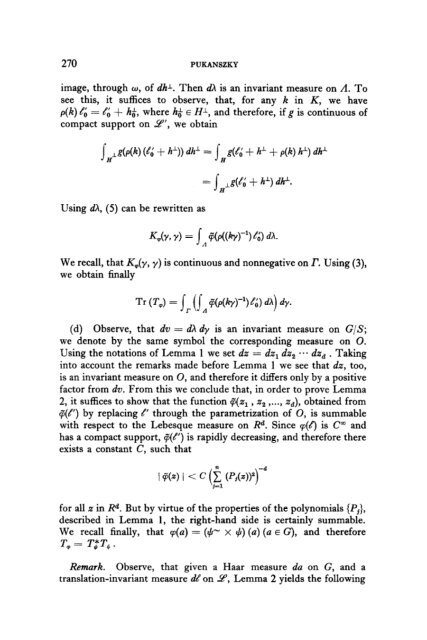On the Characters and the Plancherel Formula of Nilpotent Groups ...
On the Characters and the Plancherel Formula of Nilpotent Groups ...
On the Characters and the Plancherel Formula of Nilpotent Groups ...
Create successful ePaper yourself
Turn your PDF publications into a flip-book with our unique Google optimized e-Paper software.
270 PUKANSZKY<br />
image, through w, <strong>of</strong> dbl. Then dA is an invariant measure on A. To<br />
see this, it suffices to observe, that, for any k in K, we have<br />
p(k) 4; = 8; + &, where hi E Hl, <strong>and</strong> <strong>the</strong>refore, if g is continuous <strong>of</strong><br />
compact support on Y, we obtain<br />
Using dA, (5) can be rewritten as<br />
We recall, that K,(y, y) is continuous <strong>and</strong> nonnegative on I’. Using (3),<br />
we obtain finally<br />
(d) Observe, that de, = dA dy is an invariant measure on G/S;<br />
we denote by <strong>the</strong> same symbol <strong>the</strong> corresponding measure on 0.<br />
Using <strong>the</strong> notations <strong>of</strong> Lemma 1 we set dz = dz, dz, *+* dz, . Taking<br />
into account <strong>the</strong> remarks made before Lemma 1 we see that dz, too,<br />
is an invariant measure on 0, <strong>and</strong> <strong>the</strong>refore it differs only by a positive<br />
factor from dv. From this we conclude that, in order to prove Lemma<br />
2, it suffices to show that <strong>the</strong> function +(z, , za ,..., zd), obtained from<br />
$(e’) by replacing d’ through <strong>the</strong> parametrization <strong>of</strong> 0, is summable<br />
with respect to <strong>the</strong> Lebesque measure on Rd. Since ~(4’) is C” <strong>and</strong><br />
has a compact support, +(e’) is rapidly decreasing, <strong>and</strong> <strong>the</strong>refore <strong>the</strong>re<br />
exists a constant C, such that<br />
for all z in R”. But by virtue <strong>of</strong> <strong>the</strong> properties <strong>of</strong> <strong>the</strong> polynomials {Pj},<br />
described in Lemma 1, <strong>the</strong> right-h<strong>and</strong> side is certainly summable.<br />
We recall finally, that ~(a) = ($- x 4) (a) (a E G), <strong>and</strong> <strong>the</strong>refore<br />
T, = T,*T,.<br />
Remark. Observe, that given a Haar measure da on G, <strong>and</strong> a<br />
translation-invariant measure d/ on 9, Lemma 2 yields <strong>the</strong> following

















